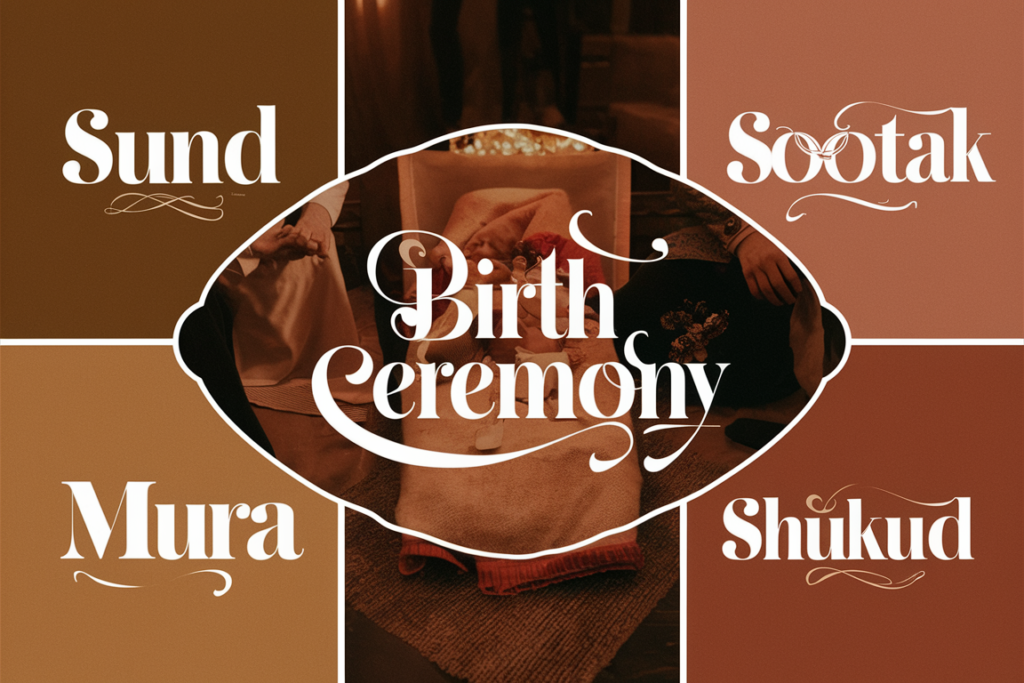Birth Ceremonies – Himachal GK
- At the time of child birth, the mother is housed in a separate room and usually in the lower storey of the house. This is to protect her from the cold and high wind of the hills. In the tribal areas, she is often lodged in a cattle manor (Gohad).
- Immediately after the birth the mother is made to drink a mixture of ghee and gur called ‘Gurani’ and eats sweetened porridge and takes a mixture of milk and ghee to strengthen her. Sometimes wine is also given.
HP Assistant Conservators of Forests (ACF)-2025 Prelims Mock Test Series
[12 Full Length Tests]
- The first twenty days (in some cases only ten days) are called ‘Sootak’ or ‘Sakor’ and during this period, the family observes all religious rituals. During this period, no one accepts food and drink from the hands of newly become mother. After the Sootak period is over, the cleansing up ceremony takes place, presided over usually by a Brahmin or a Buddhist priest (Lama). A mixture of curd, sugar, cow’s urine, milk and Gangajal is sprinkled over all the clothes in the house and is tasted by all the young and the old members of the family. A spoon of the same is sipped by the mother.
- A good natured member of the family is selected to administer ‘Ghutti’ to the child. It is first feeding of the infant. It is believed that the child imbibes the temperament of the person who gives him/her first dose of Ghutti.
- ‘Goontar’ or ‘Dassotan’ ceremony is celebrated on the birth of a child by well to do families and on this occasion special ‘Sund’ (sweet cookies) is made from dry fruits and distributed among the close relatives and villagers. It is held on the tenth day after birth. After the Goontar ceremony is over, the mother along with the newborn goes to the family’s living room.
- In Himachal Pradesh, a husband refrains from killing an animal with his own hands during his wife’s pregnancy, but he may eat meat. A pregnant woman must not go to a place on fire, stream, forest etc. She is not to see the face of a dead person. She is also prohibited for having a look at a solar or lunar eclipse. Her old ornaments are not melted to form other ornaments during her pregnancy.
- The birth of a male child is announced by distributing ‘Mura’ made of sugar lumps or parched grains among friends and relatives on the day of the birth.
- At the birth of a son in the eastern Himachal Pradesh the temple musicians, locally called ‘Dhakis’ or ‘Turis’ play the music called ‘Shabad’ at the door of the family.
- People light lamps and the women from the neighborhood come and sing songs of joy and congratulations i.e. Sohar Badhaiyan. The relatives and friends congratulate the father of the boy and offer him ‘turf leaves’ with one rupee. The father keeps the turf leaves and returns the rupee with double the amount. This custom is called ‘Badhai’.
- In the Kinnaur area, the well to do bring the palanquins of the gods within their house after a male child is delivered and feast the villagers on rich food and liquor. This custom is known as ‘Shukud’. At this time, a goat may be sacrificed.
- Among the Brahmins, the Namkaran (the naming of the infant), ‘Chudakaran’ (first snipping off his locks), Annaprashan (the first tasting of cereals by the baby) are all performed with great joy. In some areas in Solan, the infant is taken to a water fall and lodged near it for the first three days.
- For the naming ceremony, the first letter of the name is ascertained by the family priest from the child’s horoscope.
- The first hair cutting ceremony of the child takes place in the third, fifth or seventh year after the birth. It is an occasion of great religious significance. This is called ‘Jatloo’. It is customary in the Himachal to offer the hair cut at this ceremony at the shrine of a goddess or in the temple of ‘Shiva’ or the shrine of ‘Kulja’or Holy River to receive blessings for the child and prevent its sacred first hair from being defiled.
HP Assistant Conservators of Forests (ACF)-2025 Prelims Mock Test Series
[12 Full Length Tests]
Summary
- Sootak – The first twenty days or in some cases only ten day after the birth of child.
- Ghutti – first feeding of the infant.
- Goontar or Dassotan – held on the tenth day after birth of child.
- Sund – sweet cookies made from dry fruits on the occasion of Goontar.
- Mura – made of sugar lumps or parched grains.
- Dhakis or Turis – temple musicians.
- Shukud – celebrated in Kinnaur on the birth of male child.
- Jatloo – The first hair cutting ceremony of the child.
HP Assistant Conservators of Forests (ACF)-2025 Prelims Mock Test Series
[12 Full Length Tests]
जन्म समारोह
- बच्चे के जन्म के समय, माँ को एक अलग कमरे में और आमतौर पर घर की निचली मंजिल में रखा जाता है। यह उसे पहाड़ियों की ठंड और तेज़ हवा से बचाने के लिए है। जनजातीय क्षेत्र में, उसे अक्सर मवेशियों के बाड़े (गोहद) में रखा जाता है।
- जन्म के तुरंत बाद माँ को घी और गुड़ का मिश्रण पिलाया जाता है जिसे ‘गुरानी’ कहा जाता है और मीठा दलिया खाने को दिया जाता है और उसे मज़बूत बनाने के लिए दूध और घी का मिश्रण दिया जाता है। कभी-कभी शराब भी दी जाती है।
HP Assistant Conservators of Forests (ACF)-2025 Prelims Mock Test Series
[12 Full Length Tests]
- पहले बीस दिन (कुछ मामलों में केवल दस दिन) को ‘सूतक’ या ‘सकोर’ कहा जाता है और इस अवधि के दौरान, परिवार सभी धार्मिक अनुष्ठान करता है। इस अवधि के दौरान, कोई भी नई माँ के हाथों से खाना-पीना स्वीकार नहीं करता है। सूतक अवधि समाप्त होने के बाद, शुद्धिकरण समारोह होता है, जिसकी अध्यक्षता आमतौर पर एक ब्राह्मण या बौद्ध पुजारी (लामा) करते हैं। दही, चीनी, गाय का मूत्र, दूध और गंगाजल का मिश्रण घर के सभी कपड़ों पर छिड़का जाता है और परिवार के सभी छोटे-बड़े सदस्य इसका स्वाद लेते हैं। मां भी इसका एक चम्मच पीती है। बच्चे को घुट्टी पिलाने के लिए परिवार के किसी अच्छे स्वभाव वाले सदस्य का चयन किया जाता है। यह शिशु का पहला आहार होता है। ऐसा माना जाता है कि बच्चा उस व्यक्ति के स्वभाव को अपना लेता है जो उसे घुट्टी की पहली खुराक देता है। संपन्न परिवारों में बच्चे के जन्म पर ‘गूंतर’ या ‘दसोटन’ समारोह मनाया जाता है और इस अवसर पर सूखे मेवों से विशेष ‘सुंड’ (मीठी कुकीज) बनाकर करीबी रिश्तेदारों और ग्रामीणों में बांटा जाता है। यह जन्म के दसवें दिन मनाया जाता है। गूंतर समारोह समाप्त होने के बाद, मां नवजात शिशु के साथ परिवार के लिविंग रूम में जाती है। हिमाचल प्रदेश में, एक पति अपनी पत्नी के गर्भावस्था के दौरान अपने हाथों से किसी जानवर को मारने से परहेज करता है, लेकिन वह मांस खा सकता है। गर्भवती स्त्री को आग, नदी, जंगल आदि स्थानों पर नहीं जाना चाहिए। उसे मृत व्यक्ति का मुख नहीं देखना चाहिए। उसे सूर्य या चंद्र ग्रहण देखने की भी मनाही है। गर्भावस्था के दौरान उसके पुराने आभूषणों को पिघलाकर अन्य आभूषण नहीं बनाए जाते।
- जन्म के दिन मित्रों और रिश्तेदारों में चीनी की डली या भुने हुए अनाज से बना ‘मूरा’ बाँटकर लड़के के जन्म की घोषणा की जाती है।
- पूर्वी हिमाचल प्रदेश में बेटे के जन्म पर मंदिर के संगीतकार, जिन्हें स्थानीय रूप से ‘ढाकी’ या ‘टूरी’ कहा जाता है, परिवार के दरवाजे पर ‘शबद’ नामक संगीत बजाते हैं।
- लोग दीये जलाते हैं और पड़ोस की महिलाएँ आकर खुशी और बधाई के गीत गाती हैं यानी सोहर बधाइयाँ। रिश्तेदार और दोस्त लड़के के पिता को बधाई देते हैं और उन्हें एक रुपये के साथ ‘तुरही’ भेंट करते हैं। पिता तुरही को अपने पास रख लेता है और दुगनी राशि के साथ रुपया लौटाता है। इस प्रथा को ‘बधाई’ कहा जाता है।
- किन्नौर क्षेत्र में, धनी लोग पुत्र के जन्म के बाद देवताओं की पालकी अपने घर लाते हैं और ग्रामीणों को स्वादिष्ट भोजन और मदिरा का भोज देते हैं। इस प्रथा को ‘शुकुड़’ के नाम से जाना जाता है। इस समय बकरे की बलि दी जा सकती है। ब्राह्मणों में, नामकरण (शिशु का नामकरण), ‘चूड़ाकरण’ (पहली बार उसके बाल काटना), अन्नप्राशन (शिशु द्वारा अनाज का पहला स्वाद लेना) सभी बहुत खुशी के साथ किए जाते हैं। सोलन के कुछ क्षेत्रों में, शिशु को पहले तीन दिनों के लिए झरने के पास ले जाया जाता है और उसके पास रखा जाता है। नामकरण समारोह के लिए, नाम का पहला अक्षर बच्चे की कुंडली से पारिवारिक पुजारी द्वारा पता लगाया जाता है। बच्चे का पहला बाल काटने का समारोह जन्म के बाद तीसरे, पांचवें या सातवें वर्ष में होता है। यह बहुत धार्मिक महत्व का अवसर है। इसे ‘जटलू’ कहा जाता है। हिमाचल में इस समारोह में बाल कटवाने की प्रथा है, जो देवी के मंदिर या ‘शिव’ के मंदिर या ‘कुलजा’ या पवित्र नदी के मंदिर में बच्चे के लिए आशीर्वाद प्राप्त करने और उसके पवित्र पहले बालों को अपवित्र होने से बचाने के लिए की जाती है।
HP Assistant Conservators of Forests (ACF)-2025 Prelims Mock Test Series
[12 Full Length Tests]
सारांश
- सूतक – बच्चे के जन्म के बाद पहले बीस दिन या कुछ मामलों में केवल दस दिन।
- घुट्टी – शिशु को पहली बार दूध पिलाना।
- गूँतर या दस्सोतन – बच्चे के जन्म के दसवें दिन मनाया जाता है।
- सुंड – गूँतर के अवसर पर सूखे मेवों से बनी मीठी कुकीज़।
- मुरा – चीनी की गांठों या भुने हुए अनाज से बना।
- ढाकी या तुरी – मंदिर के संगीतकार।
- शुकुड़ – किन्नौर में लड़के के जन्म पर मनाया जाता है।
- जटलू – बच्चे के बाल काटने की पहली रस्म।
HP Assistant Conservators of Forests (ACF)-2025 Prelims Mock Test Series
[12 Full Length Tests]

 Users Today : 6
Users Today : 6 Total Users : 6675
Total Users : 6675 Views Today : 6
Views Today : 6 Total views : 11105
Total views : 11105 Who's Online : 0
Who's Online : 0